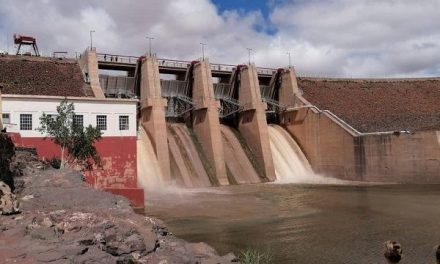
Weather 10 July 2015
 What Happened
What Happened
Weird winter is perhaps the only suitable description for this week’s weather. As is customary for mid-winter, a high pressure cell was present over most of South Africa but also covering two thirds of Botswana and the western sliver of Zimbabwe. This produced cool but stable conditions with a very slow anti-cyclonic circulation. All in all not unfamiliar.
Off the Namibian coastline the South Atlantic high remained of moderate strength with the core about 1000 km offshore. Between the high over land in the east and the high over the sea in the west, an area of lower pressure existed but not strong enough to be classified as a trough. The interplay between these dynamic elements gave typical winter conditions, but of a relatively mild nature.
A cold front passed Cape Agulhas earlier in the week pushed along by the migrating South Atlantic high. Its impact in Namibia, however, was limited.
The reason for this lay in the location of a strong vortex some 1000 km south-east of the Eastern Cape. This vortex was driven by two reciprocating engines. From the west the approaching South Atlantic high provided the south to north motion and on the low’s eastern flank, the Southern Indian high provided the north to south push. The result was the strong vortex. What happened then is that the South Atlantic high, as it shifts over the continent, is eroded towards the south-east, meaning it gets sucked away from Namibia and dissipates into the upper atmosphere south of Madagascar. This dramatically reduces its cold reach further north.
Ahead of the cold front, warm air flowed from north to south. This huge conveyor linked up with the lower pressure area over western Namibia and created one long contiguous band of north to south airflow. The result: mild days over Namibia’s interior with a north-easterly bias to the airflow on the surface. Behind the cold front, cold antarctic air was advected north, also in a contiguous band of interlinked vortices behind the cold front. However, when the cold air reached the Southern Cape, it was deflected to the east where it created rainy conditions over the eastern littoral, but with very little effect further north and west, notably Botswana and Namibia.
As a matter of fact, the surface anti-cyclonic circulation over the sub-continent was so dominant that the customary low pressure area formed over the coastal plain of the northern Namib. The pressure differential between the interior (from 1024 to 1028 mB) and the coastal plain (1016 to 1012 mB) manifested in strong Oosweer conditions on Thursday and Friday. Further south, over the southern Namib, the so-called anabatic effect was very strong, creating hot conditions as the compressing air released energy. This is very typical for the southern Namib, but it is a bit early. It is what one would usually expect late August to early September, after the impact from the winter rainfall season at the Cape, has subsided.
What’s Coming
The weekend starts with the South Atlantic high stretching across almost the entire South Atlantic from the South American coastline to the African continent and merging with the high pressure cell over South Africa. Like in previous occurrences this winter, the presence of this elongated, extended South Atlantic high acts as a buffer shielding the continent from the severe antarctic cold as this air gets advected to the north.
During Saturday, the strong airflow from the north keeps bringing in warmer air from Angola which crosses Namibia from the Cunene to the Kalahari. This warmer air splits the high pressure cell into two, reverting to the normal positions over the ocean and over the continent. This creates a south to north corridor on the leading (eastern) edge on the South Atlantic high which should see temperatures drop during Sunday, especially in the Karas Region. This system migrates from west to east and while doing so, will bring colder (cool) conditions to the Hardap Region and then to Khomas. By Monday evening, the cold intrusion should be over the Kalahari with colder conditions along the Botswana border on Tuesday. No frost is expected.
Due to the dominant airflow from the north, conditions quickly revert to mild from the middle of next week.











































